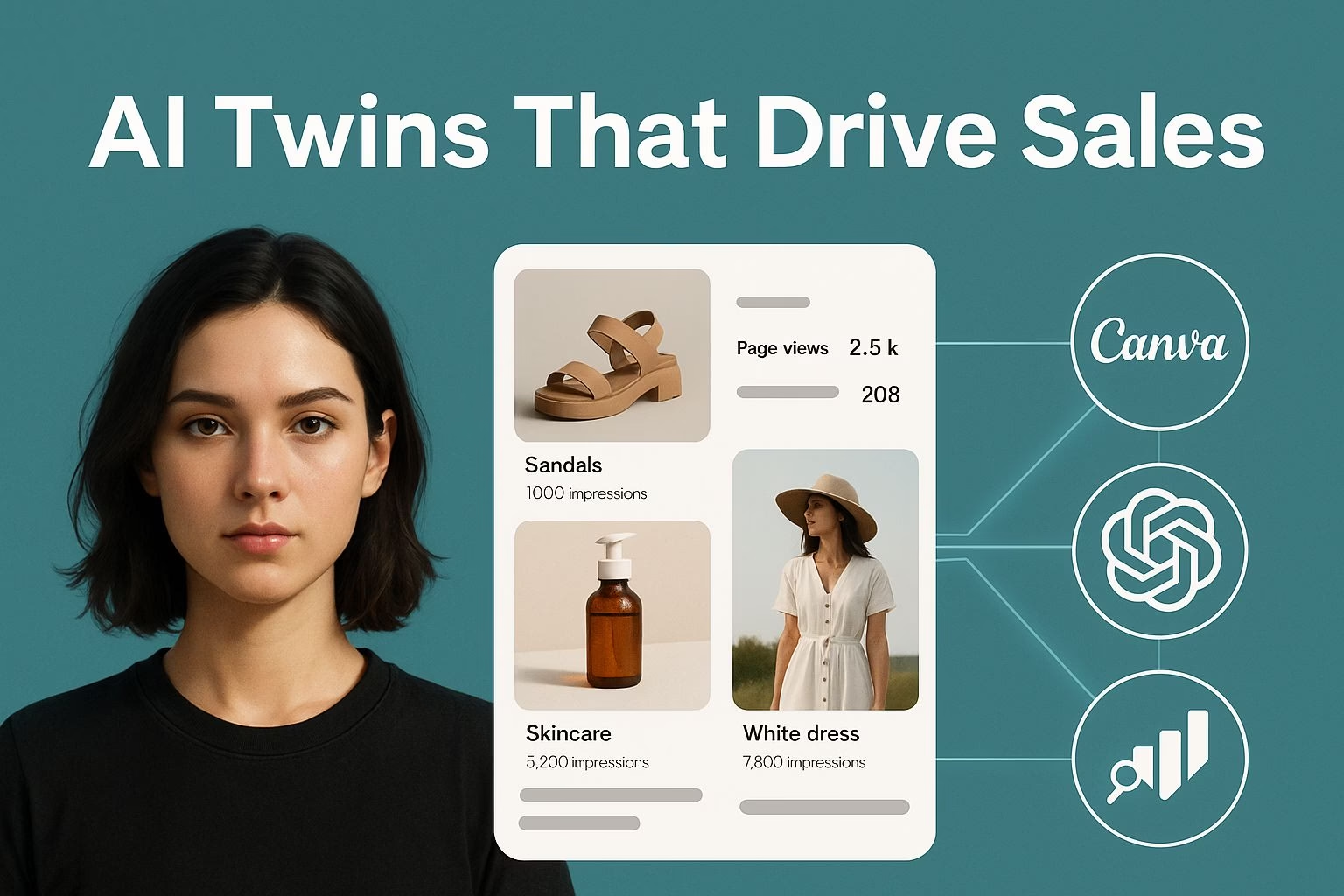AI Tools Behind the Rise of AI Twins That Actually Drive Sales
Summary
- AI Twins only start earning when backed by the right system, not visuals alone.
- Ideogram, Leonardo AI, and Flux Pro handle creation; Canva, CapCut, and Pika Labs handle presentation.
- ChatGPT, Gemini, and Notion AI keep the workflow structured and consistent.
- Free marketing tools like Pinterest, Facebook Groups, and SEO platforms generate steady organic traffic.
- Combining all stages, creation, system, and promotion, turns AI content into real income.
Everywhere you look, people are posting AI Twins and faceless visuals. They look stunning, but most creators don’t know how to turn them into something that actually earns money.
The truth is, generating visuals is just the start; building a system around them is what creates consistent income.
AI Twins can become more than digital portraits. When combined with the right workflow, they can help you grow a brand, automate content creation, and generate passive revenue streams.
It’s not about posting for likes; it’s about creating assets that work while you sleep.
In this article, I’ll walk through the exact tools used to build and scale an AI faceless business, the same tools behind those viral AI Twins posts.
Each one serves a specific purpose: creation, editing, marketing, or management. When used together, they form a simple structure for turning creativity into income.
Let’s go step by step.
Tools that Create Realistic AI Twins
The foundation of any AI faceless business starts with visual creation.
These tools bring digital twins and brand imagery to life with professional-level detail.
-
Ideogram – Known for its strong typography and realistic compositions. It’s great for creators who want words integrated seamlessly into their images.
-
Leonardo AI – Ideal for portraits, stylized branding, and cohesive aesthetic themes. Many creators use it to design their main AI characters.
-
Flux Pro (on Fal.AI) – Delivers cinematic lighting and depth that makes AI Twins stand out in social feeds.
Once your visuals are ready, tools like Blaze Autopilot can help you automate publishing and analytics, so your content flows smoothly from creation to posting.
It’s a quiet but powerful way to keep your workflow consistent without spending hours managing uploads.
Each tool has a unique strength, and experimenting with prompts is key to finding your style.
Once you start building consistency in your visuals, they naturally become part of your brand identity.
Turning Visuals into Content and Products
Once your visuals are ready, it’s time to transform them into usable assets. This is where most creators fall short.
The right tools help you move from static images to high-performing products and videos.
Canva, CapCut, and Pika Labs each play a role in this process:
-
Canva helps build mockups, Pinterest pins, and digital templates for products or ads.
-
CapCut makes editing short videos fast, perfect for TikTok or Instagram.
-
Pika Labs converts static visuals into motion videos, adding depth and engagement.
These platforms turn your visuals into marketing material that attracts attention and drives clicks.
With templates and automation, you can produce more without losing quality or creativity.
How to script captions and organize your AI workflow
Strong visuals need clear words and a simple system. ChatGPT and Gemini help draft captions, scripts, blog posts, and product descriptions fast.
Keep prompts in one place so you can reuse what works. Notion AI is perfect for that. It stores ideas, drafts, and automation notes in a single workspace.
Write short, direct captions that match intent. Lead with the benefit, then add one call to action. For longer pieces, outline first, then expand with AI.
Edit for clarity and tone so it sounds human. Keep templates for product pages, YouTube descriptions, and Pinterest pins to speed up repeat tasks.
Treat your process like a loop. Create, script, publish, and review. Save the best hooks and formats inside Notion AI.
That way, each post gets faster and more consistent without losing quality.
How to market AI faceless content with free traffic
You win when people can find your work without ads. Pinterest, Facebook Groups, and SEO tools like Ubersuggest, Ahrefs, and SurferSEO show you what the audience already wants.
Build content around those searches and you’ll get steady traffic.
-
Start with a small keyword set from Ubersuggest or Ahrefs.
-
Turn each keyword into a pin, a short video, and a simple blog page.
-
Use SurferSEO to structure the page so it matches search intent.
-
Share finished posts in the right Facebook Groups with helpful context.
-
Pin daily and repurpose clips for TikTok, Reels, and Shorts.
Keep publishing on a schedule. Track which pins and posts drive clicks and saves. Double down on those angles. That steady flow is what powers sales over time.
Connecting Creation and Sales
Many creators get stuck between making content and actually selling it. They focus on visuals but forget the link between design, search intent, and monetization.
The real shift happens when you connect your creative tools with an SEO-driven strategy.
Think of it as a bridge. Your AI Twins and faceless visuals live on one side, and your potential buyers live on the other.
What connects them is content that answers what people are searching for. Use your visuals as entry points, then lead viewers toward offers, guides, or templates built around their interests.
Each image, video, or post should have a goal. Whether that’s collecting emails, driving product clicks, or building brand awareness, clarity keeps your system moving.
Once everything ties back to traffic and conversions, your content becomes a self-sustaining loop.
Building a Long-Term AI Faceless Business
The goal isn’t to chase trends. It’s to build something that earns while you sleep.
This happens when your AI projects have structure, consistency, and an audience base that grows naturally.
Each tool you use should fit into one of three categories: creation, system, or promotion. Together, they form a business that runs with minimal effort once set up properly.
-
Creation tools: Ideogram, Leonardo AI, and Flux Pro
-
System tools: Notion AI, ChatGPT, and Gemini
-
Promotion tools: Pinterest, Facebook Groups, and SEO platforms like Ubersuggest, Ahrefs, and SurferSEO
When you stay consistent with this structure, you’ll start seeing predictable results. The process becomes simple: create quality visuals, organize your workflow, and use search data to attract attention.
That’s how you move from posting AI Twins for fun to running a scalable business that drives sales.

